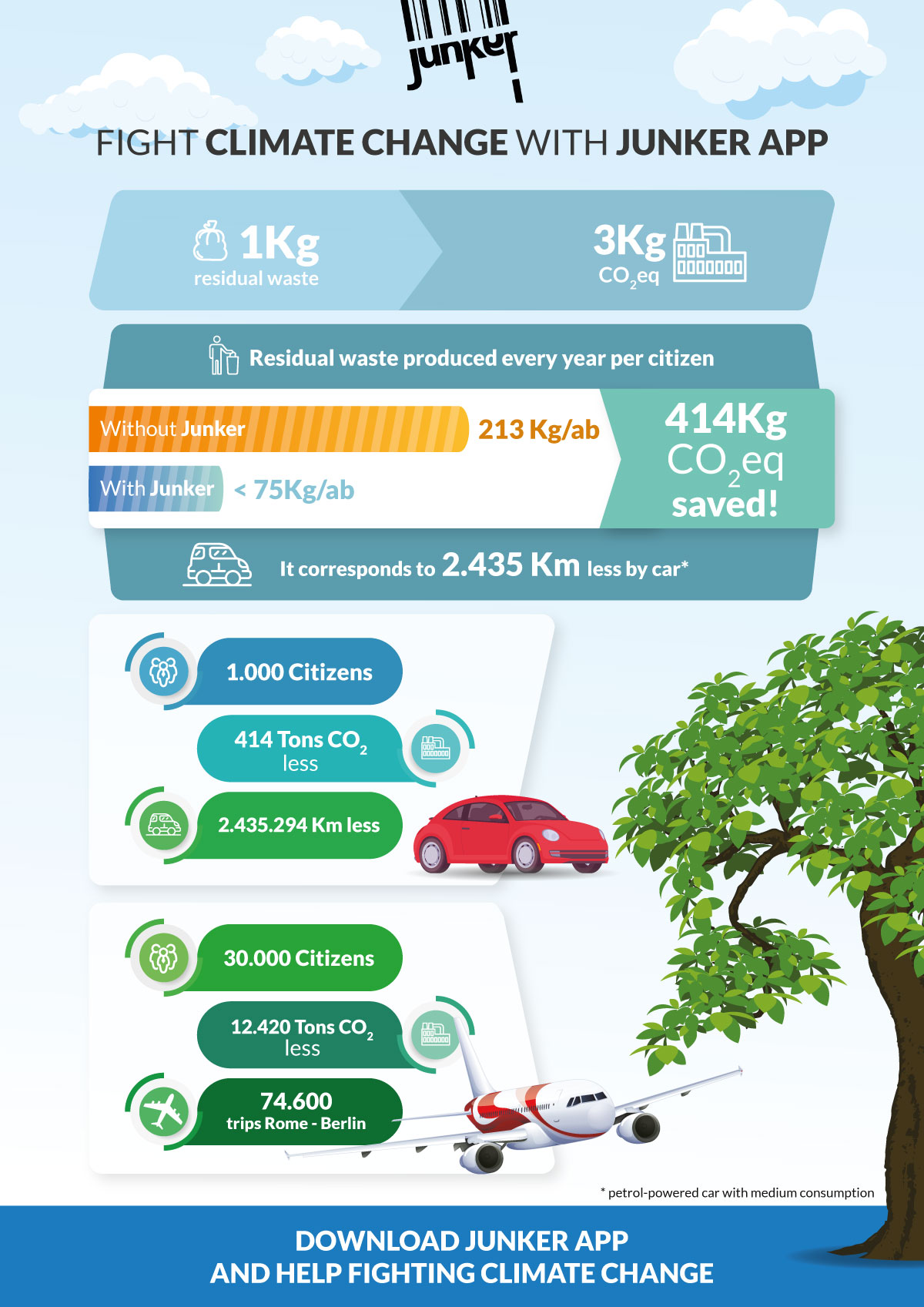Nov 12, 2019
[:en]Fight climate change every day with Junker App[:]

[:en]Junker App contributes to achieve some of the 17 Sustainable Development Goals of the 2030 UN-Agenda by helping people sort waste in a correct way. In particular, Junker’s activities are in line with three goals: Goal 11 – Sustainable Cities and Communities, which includes the reduction of the environmental impact due to urban waste management; Goal 12 – Responsible Consumption and Production, which foresees to reduce waste production by reusing, recycling, preventing; Goal 13 – Climate Action.
The reader could wonder what the link between the reduction of urban waste and, for instance, the rise of global temperatures or the release of CO2 in the atmosphere is. Such link may not be immediate, but waste production, management and disposal, especially for residual waste, have a proved, big environmental impact as regards CO2 emissions.
Junker gives a concrete help to municipalities to reduce CO2 emissions deriving from urban waste management, by maximizing the reduction of the residual waste fraction in favor of the recyclable ones, such as plastics, paper, organic waste. We would like to show you how this is possible with some simple calculations that may help municipalities understand the possible reduction in emissions thanks to the use of Junker App. You don’t believe us? Let’s find it out together!
THE EXPERIMENT
According to Ispra (National Institute for Environmental Protection and Research), in 2017 every Italian citizen produced 497 kg of urban waste, of which 213 kg were residual waste. Italian municipalities with best recycling rates, ranked by Legambiente (Italian environmental NGO), have a goal to achieve: stay under 75kg of residual waste per person[1]. Thus, the difference between this goal and the current quantity of produced residual waste is 138 kg.
Disposing 1 kg of residual waste produces an amount of 3 kg of equivalent CO2[2]. If one got rid of 138 kg of residual waste which divides the national average from the above-mentioned objective, one would save 414 kg CO2eq that would not be released into the atmosphere. It is as if a petrol-powered car with a medium consumption drove 2.435 km less every year.
Here comes the interesting part for the municipalities: by multiplying this number for a hypothetical number of citizens, let’s say 1000, one would save 414 tons of CO2eq, which means 2.435.294 km less by car! According to this argument, if Junker users really succeeded in reducing their quantity of produced residual waste and achieving the goal of 75 kg, we would estimate how much Junker could reduce CO2 emissions deriving from residual waste management in each municipality!
The municipality of Mompeo in Central Italy has tested a similar calculation model to measure the avoided CO2 emissions, which could be converted in financial bonuses (see footnote number 2), even if it was applied to a geographical area that had already achieved good environmental goals.
Limited to the environmental impact, these are the hypothetical CO2eq tons that the following municipalities could save in one year in case the current Junker users living in those cities were able to achieve the goal of 75 kg residual waste
– Torino (Piedmont) – 12.358 tons CO2
– Aprilia (Lazio) – 11.803 tons CO2
– Mentana (Lazio) – 5.127 tons CO2
– Caltanissetta (Sicily) – 4.846 tons CO2
– Bari (Apulia) – 4.730 tons CO2
– Termoli (Molise) – 4.447 tons CO2
– Minturno (Lazio) – 4.273 tons CO2
– Terni (Umbria) – 3.880 tons CO2
– Artena (Lazio) – 2.981 tons CO2
– Patti (Sicily) – 2.701 tons CO2
– Chiaramonte Gulfi (Sicily)– 1.352 tons CO2
– Trivento (Molise) – 860 tons CO2
– Rescaldina (Lombardy) – 816 tons CO2
– Castelfidardo (Marches) – 536 tons CO2
– Antrodoco (Lazio) – 429 tons CO2
– Colletorto (Molise) – 290 tons CO2
SOME EXAMPLES
The distance from Rome to Milan by car is 571 km. Covered by a petrol-powered car with medium consumption it corresponds to 96 kg/CO2[3]. A ton CO2eq is produced by covering this distance ten times; this means that, for example, the inhabitants of Artena have saved a quantity of CO2eq equal to more than 29.800 travels by car from Rome to Milan!
Another case: the distance from Rome to Berlin by plane is 1198 km, which correspond to 167 kg/CO2[4]. A ton of CO2eq is produced by covering this distance about 6 times; this means that, for instance, the inhabitants of Aprilia have saved a quantity of CO2eq equal to more than 70.800 travels by plane from Rome to Berlin!
Incredible, isn’t it? And all this is possible just by recycling correctly every day, supported by Junker that can clarify your doubts.
Goal: minimizing residual waste!
Millions of little actions will concretely contribute to the great necessary change.
__________________
[1] Legambiente, Comuni Ricicloni: il dossier, http://www.ricicloni.it/assets/files/a8/c2/comuni-ricicloni-2019.pdf
[2] A. Valentini, E. Vergalito, N. De Santis, B. De Santis. Carbon Waste Print: un nuovo metodo di calcolo della CO2 evitata, per sistemi di tariffazione puntuale in base al servizio reso
More information about the project: http://carbonwasteprint.com/la-prima-sperimentazione/
U.S. Environmental Protection Agency, “Documentation for Greenhouse Gas Emission and Energy Factors Used in the Waste Reduction Model (WARM)”, ICF International, 2016
Wrap, “A methodology for quantifying the environmental and economic impacts of reuse”, Final Report, 2011, www.wrap.org.uk
[3] https://www.greentripper.org/calculator.aspx?cl=en&ol=7
[4] https://www.greentripper.org/calculator.aspx?cl=en&ol=6[:]



















